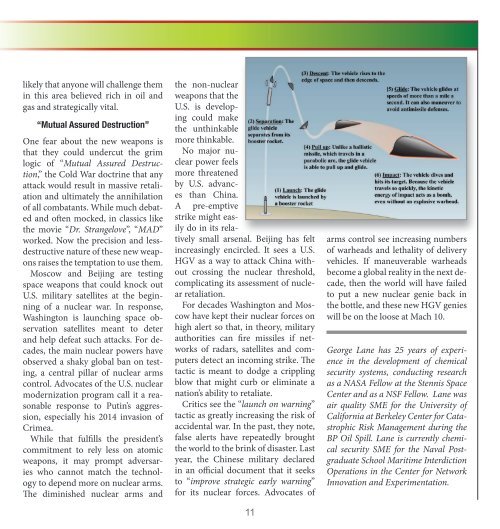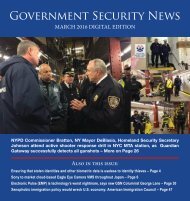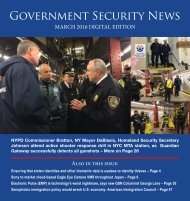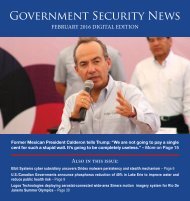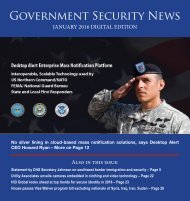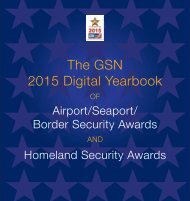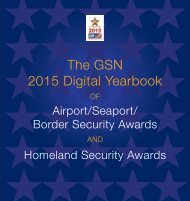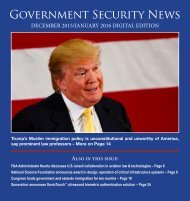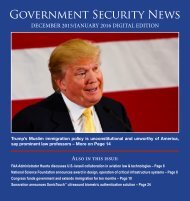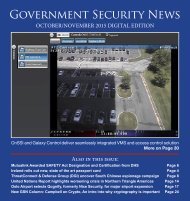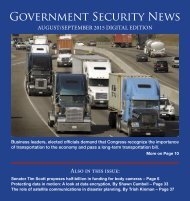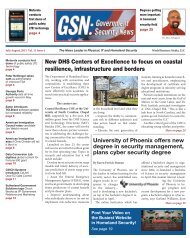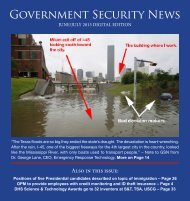GSN Digital Edition April 2016
You also want an ePaper? Increase the reach of your titles
YUMPU automatically turns print PDFs into web optimized ePapers that Google loves.
likely that anyone will challenge them<br />
in this area believed rich in oil and<br />
gas and strategically vital.<br />
“Mutual Assured Destruction”<br />
One fear about the new weapons is<br />
that they could undercut the grim<br />
logic of “Mutual Assured Destruction,”<br />
the Cold War doctrine that any<br />
attack would result in massive retaliation<br />
and ultimately the annihilation<br />
of all combatants. While much debated<br />
and often mocked, in classics like<br />
the movie “Dr. Strangelove”, “MAD”<br />
worked. Now the precision and lessdestructive<br />
nature of these new weapons<br />
raises the temptation to use them.<br />
Moscow and Beijing are testing<br />
space weapons that could knock out<br />
U.S. military satellites at the beginning<br />
of a nuclear war. In response,<br />
Washington is launching space observation<br />
satellites meant to deter<br />
and help defeat such attacks. For decades,<br />
the main nuclear powers have<br />
observed a shaky global ban on testing,<br />
a central pillar of nuclear arms<br />
control. Advocates of the U.S. nuclear<br />
modernization program call it a reasonable<br />
response to Putin’s aggression,<br />
especially his 2014 invasion of<br />
Crimea.<br />
While that fulfills the president’s<br />
commitment to rely less on atomic<br />
weapons, it may prompt adversaries<br />
who cannot match the technology<br />
to depend more on nuclear arms.<br />
The diminished nuclear arms and<br />
the non-nuclear<br />
weapons that the<br />
U.S. is developing<br />
could make<br />
the unthinkable<br />
more thinkable.<br />
No major nuclear<br />
power feels<br />
more threatened<br />
by U.S. advances<br />
than China.<br />
A pre-emptive<br />
strike might easily<br />
do in its relatively<br />
small arsenal. Beijing has felt<br />
increasingly encircled. It sees a U.S.<br />
HGV as a way to attack China without<br />
crossing the nuclear threshold,<br />
complicating its assessment of nuclear<br />
retaliation.<br />
For decades Washington and Moscow<br />
have kept their nuclear forces on<br />
high alert so that, in theory, military<br />
authorities can fire missiles if networks<br />
of radars, satellites and computers<br />
detect an incoming strike. The<br />
tactic is meant to dodge a crippling<br />
blow that might curb or eliminate a<br />
nation’s ability to retaliate.<br />
Critics see the “launch on warning”<br />
tactic as greatly increasing the risk of<br />
accidental war. In the past, they note,<br />
false alerts have repeatedly brought<br />
the world to the brink of disaster. Last<br />
year, the Chinese military declared<br />
in an official document that it seeks<br />
to “improve strategic early warning”<br />
for its nuclear forces. Advocates of<br />
11<br />
arms control see increasing numbers<br />
of warheads and lethality of delivery<br />
vehicles. If maneuverable warheads<br />
become a global reality in the next decade,<br />
then the world will have failed<br />
to put a new nuclear genie back in<br />
the bottle, and these new HGV genies<br />
will be on the loose at Mach 10.<br />
George Lane has 25 years of experience<br />
in the development of chemical<br />
security systems, conducting research<br />
as a NASA Fellow at the Stennis Space<br />
Center and as a NSF Fellow. Lane was<br />
air quality SME for the University of<br />
California at Berkeley Center for Catastrophic<br />
Risk Management during the<br />
BP Oil Spill. Lane is currently chemical<br />
security SME for the Naval Postgraduate<br />
School Maritime Interdiction<br />
Operations in the Center for Network<br />
Innovation and Experimentation.


